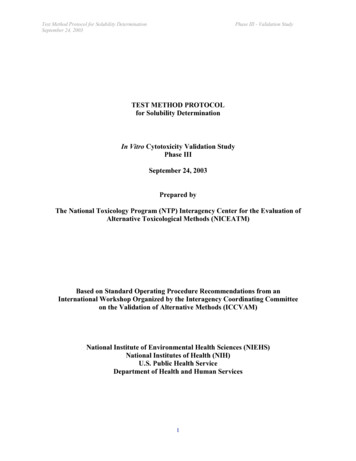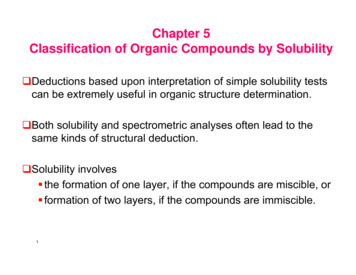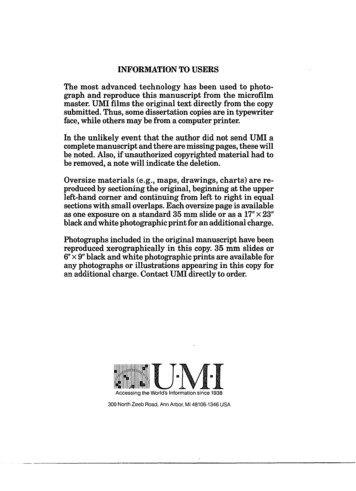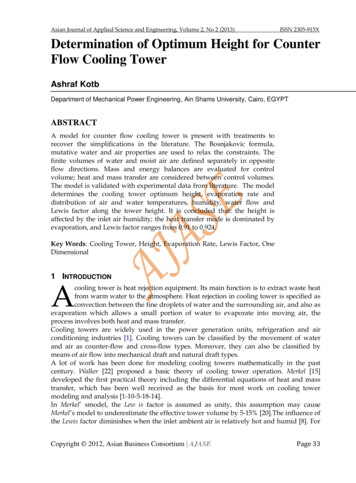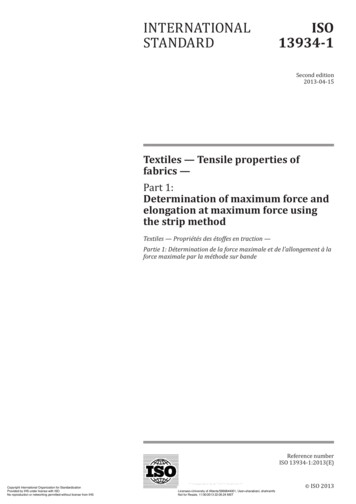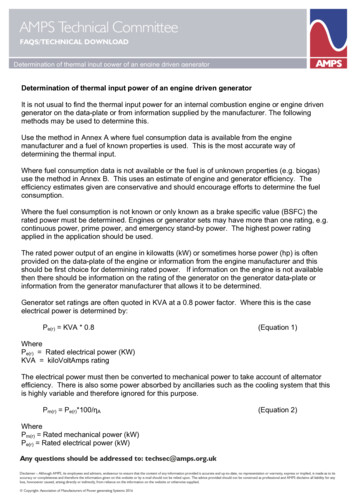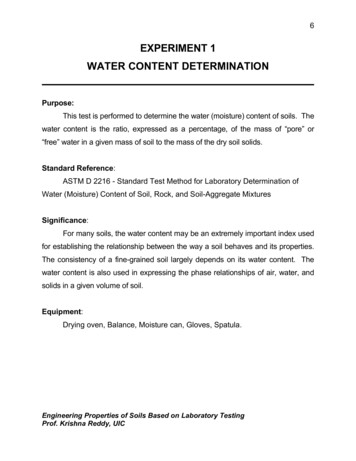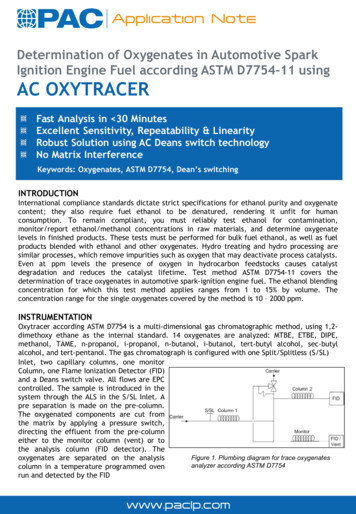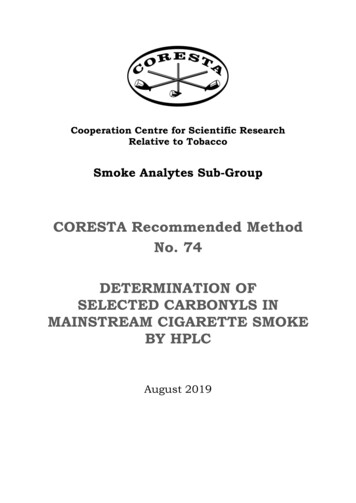
Transcription
Determinationof Solubility ClassAssistant Lecturer:Sahar Mohammed ShakirAssistant Lecturer:Sarah Sattar Jabbar
Solubility classification of organic cpd. givesan idea about:1- The type of the functional group present inthe cpd.2. The polarity & the molecular weight of thecpd., ( Hydrocarbons are insoluble in waterbecause of their non polar nature , and ifan unknown cpd. is partially soluble inwater this indicates that a polar functionalgroup is present ).As the M.wt. increases, the water solubilitydecreases ( C 5 water soluble ).3. The nature of the compound (acidic, basic,neutral ).
Solubility Classification of organic cpd.sis accomplished by testing the solubility ofthe compounds in the following solvents:– Distilled water.– Ether.– 5% sodium hydroxide solution.– 5% sodium bicarbonate solution.– 5% hydrochloric acid solution.– Cold concentrated sulfuric acid.
The solubility in certain solvents often leadsto more specific information about the functional group.For example: Benzoic acid is insoluble in water ,but it is converted by 5% NaOH solution tosodium benzoate salt which is readily solublein water. When an unknown cpd. is insoluble in waterand soluble in 5% NaOH sol. this indicatesthe presence of an acidic functional group.
Generally , and for solubility classificationpurposes, the cpd. is said to be soluble in anysolvent if it dissolves to the extent of about3% ( 0.1gm/3 ml or 0.2 ml/3 ml ) . This is achieved by dissolving about 0.1 gmof solid or 3-4 drops of liquid organic cpd. ingradually increasing volumes of the solventup to 3 ml ( maximum allowed volume) withshaking. When the cpd. is more soluble in aqueousacid or aqueous base than in water , suchincreased solubility is the desired positivetest for acidic or basic functional groups.
Water Water is a polar solvent with a dielectricconstant equals to 80. It has the ability to form hydrogen bonding. It is amphoteric, it can act either as an acidor a base.Therefore it can dissolve:1. Salts of ammonium ion ( RNH4 ) or organicacids salts with alkali metal cations (RCOO -).2. Ionic compounds.3. Polar compounds “ like dissolves like ”.4. Organic cpd.s with low m.wt ( carbon 5 )such as alcohols, carboxylic acids , aldehydes& ketones .
Ether Ether is a non polar solvent having adielectric constant of 4.3 . It cannot form H-bond (unassociated liquid).It differs from water in that: It can not dissolve ionic cpd.s such as salts. It is an organic solvent for non polar cpd.s( like dissolves like ). It dissolves most water insoluble cpd.s ;therefore, in the determination of solubilityclass , the importance of ether is for watersoluble cpd.s only & no further solubilitytests using the remaining solvents are to bedone.
Accordingly, 2 probabilities are there:1- Cpd.s soluble in both water & ether.These cpd.s are : Non ionic . Contain five or less carbon atoms. Contain an active group that is polar & canform H - bond. Contain only one strong polar group.This division of cpd.s is given S1 class , itincludes, e.g.,aldehydes, ketones & aliphatic acids.
2. Cpd.s soluble in water only ( not in ether )These cpd.s are: Ionic. Contain two or more polar groups with nomore than four carbon atoms per each polargroup.This group is classified as S2 class, it includesionic salts such as salts of carboxylic acids &amines & cpd.s with more than one activegroup such as poly hydroxylated cpd.s &carbohydrates.Note: The solubility in ether is tested only for watersoluble cpd.s. for water insoluble cpd.s use the leftside of the scheme, i.e., test solubility in sodiumhydroxide solution rather than ether.
5% NaOH and 5% NaHCO3 Water insoluble cpd.s must be tested first in5% NaOH solution which is a basic solvent.It reacts with water insoluble cpd.s that arecapable of donating protons such as strong &weak acids.The stronger the acid , the weaker the base itcan react.Water insoluble cpd.s that dissolve in 5%NaOH sol. must also be tested for solubility in5% NaHCO3 sol. Therefore, for water insolubleacidic cpd.s NaOH sol. considered as adetecting solvent where as NaHCO3 sol. iscalled as a sub classifying solvent since it canreact with strong acids only.
That is, these two solvents give an idea aboutthe acidity degree of the compound. Note that testing solubility in 5% NaHCO3sol. is not needed if the cpd. is insoluble in5% NaOH sol., but rather, 5% HCl sol. shouldbe used.There are two probabilities :1. Cpd.s soluble in both bases.This group is given class A1 which includes ,strong acids “ which can react with weak bases ”,carboxylic acids & phenols with electronwithdrawing groups , e.g. ̶ NO2 “ protonsare weakly attached & can be given easily ”.
2. Cpd.s soluble in 5% NaOH sol. only.This group is given class A2 , it includes ,phenols, amides & amino acids (weak acids).5% HCl sol.If the cpd. is insoluble in water & NaOH sol. ,this mean it is not an acidic compound butrather it may be a basic, neutral or inert cpd.5% HCl sol. can dissolve basic cpd.s such asamines ( RNH2 ).If the cpd. is soluble in this solvent, then it isgiven class B, it includes primary, secondary,& tertiary amines
Cold concentrated H2SO4If the cpd. is insoluble in water, 5% NaOH sol.& 5% HCl sol. , solubility in cold conc. H2SO4should be tested.If the cpd. is soluble in this acid it belongs toclass N which includes ,neutral cpd.s such as high m.wt. alcohols,aldehydes, ketones, esters & ethers ( carbonatoms 4 ) & unsaturated hydrocarbons.On the other hand, cpd.s that are insoluble incold conc. H2SO4 belong to class I , it includesinert aliphatic ( saturated ) hydrocarbons ,aromatic hydrocarbons , haloalkanes & arylhalides.
1- Water solubility test is the 1st test to run,explain why?2- Show by chemical equation , how can coldconc. H2SO4 dissolves oxygen containingneutral cpd.?3- Determine the solubility class & the natureof the following unknowns:(a) Unknown “ X ” is insoluble in water & givesbubbles with 5% NaHCO3.(b) Unknown “ Y ” is insoluble in water ,insoluble in 5% NaOH, but solublein 5% HCl .
Robert T. Morrison , Robert N. Boyd, OrganicChemistry, sixth edition.Azhar M. Jasim , Duraid H. Mohammad ,A Laboratory Manual on Practical OrganicChemistry for 2nd year students, Universityof Baghdad , College of Pharmacy, Departmentof Pharmaceutical Chemistry, 2012.
Solubility Classification of organic cpd.s is accomplished by testing the solubility of the compounds in the following solvents: – Distilled water. – Ether. – 5% sodium hydroxide solution. – 5% sodium bicarbonate solution. – 5% hydrochloric acid solution. – Cold concentrated sulfuric acid.
